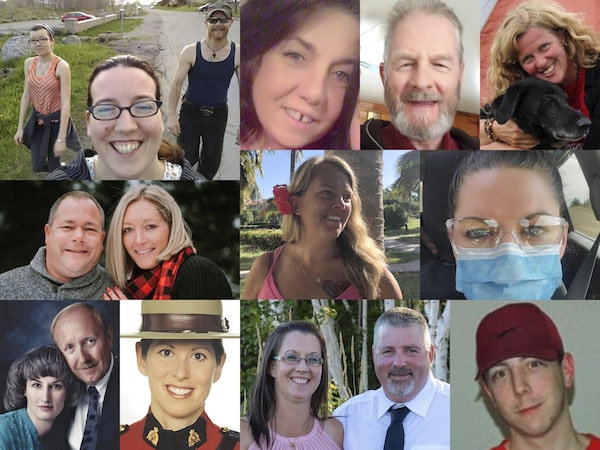
Victims of the Nova Scotia shooting. The RCMP has released only scant details about the Nova Scotia killer’s initial movements, except to confirm that his rampage began with a 'serious assault' on his girlfriend and escalated from there.
There is now confirmation that the mass murder in Nova Scotia that left 22 people dead began with an act of domestic violence, with the killer’s assault on his female partner. This means that three of the deadliest mass killings in modern Canadian history – the 2018 Toronto van attack and the 1989 massacre at Montreal’s École Polytechnique are the others – had their roots in misogyny.
And yet, despite the mounting carnage, we fail to draw any connections between these crimes, preferring to see them as unfathomable, unpredictable and random. They’re none of those things. Violence perpetrated against women is widespread, exists in a spectrum, and comes with a whole series of red flags that we continue to ignore at our peril – until the next tragedy has officials scratching their heads again, wondering how such a horrible event could occur.
As of this writing, the RCMP has released only scant details about the Nova Scotia killer’s initial movements – the RCMP’s lack of public response has been a problem in itself – except to confirm that his rampage began with a “serious assault” on his girlfriend and escalated from there.
Global News, which broke the story of the initial assault, said the killer had assaulted his girlfriend and tied her up, but that she managed to escape and later call the police. The killer had reportedly been known for troubling and controlling behaviour around his girlfriend – serious warning signs to anyone who studies intimate partner violence.
There will be hesitance to draw links between misogyny and mass violence, as there always is; it feels too “political.” In the wake of the Toronto van attack, very little attention focused on the accused perpetrator’s adherence to women-hating “incel” ideology. After the Montreal massacre, news accounts focused on the killer’s troubled upbringing and emotional trauma, despite the fact that he literally announced his hatred of “feminists” before he murdered 14 women, most of them engineering students.
It is this failure to see male violence as part of a continuum that keeps us from acting in meaningful ways from preventing it again. We give in to gun hobbyists instead of passing meaningful gun-control laws, even though guns are used in a significant percentage of femicides (the term used for the killing of girls and women because of their gender). We fail to draw connections between domestic violence and explosions of murder: In the United States, half of the 20 worst mass killings in 2018 were tied to intimate partner or family violence.
Last December, while researching a piece about whether violent misogyny should be considered a form of terrorism, I spoke to British journalist Joan Smith about her book exploring the links between partner violence and extremism, Home Grown: How Domestic Violence Turns Men into Terrorists.
“Because so much male violence is normalized, particularly when it’s domestic, and it’s not really seen as violence, we’re missing something that could actually be a huge warning sign and could help to save people’s lives,” she said.
None of this is a surprise to women who have borne the brunt of violence, or the advocates who work on their behalf. Women’s Shelters Canada – an umbrella group currently dealing with a spike in demand for its services due to the pandemic – called for a recognition that these tragedies are not isolated, but instead require a systemic response: “Until we acknowledge the role that misogyny and violence against women played in this tragedy, we cannot begin to prevent others like it.”
These are not senseless, isolated events, even if it comforts certain segments of society to think so. In fact, thinking of them as senseless and isolated releases us from responsibility for the hard fixes needed to ensure that the chain of violence is broken.
Those fixes are profound and societywide, from instituting gun control legislation to improving the grotesquely overburdened system of housing and legal support for women and children fleeing violence. They involve, at the most fundamental level, teaching boys and men how to deal with their anger in ways that do not involve emotional or physical damage to other people – or, indeed, themselves.
These are not easy solutions, but they are crucially important if we want to make sure we don’t wake up to another tragedy we just couldn’t see coming.
Keep your Opinions sharp and informed. Get the Opinion newsletter. Sign up today.